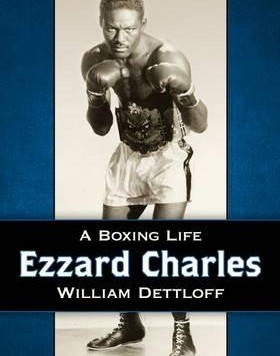George Foreman reputedly once said, “Boxing is like jazz. The better it is the less people appreciate it.” While that’s true in many cases, there are degrees to it. Miles Davis’ “Kind of Blue” is almost universally regarded as the great jazz album of all time, much as Joe Louis is regarded by many as the greatest heavyweight of all time. In either case, you don’t need a PhD to appreciate the sublime talent and technique. That’s why they’re so beloved.
In “Ezzard Charles: A Boxing Life,” William Dettloff makes the case that former heavyweight champion Ezzard Charles’ genius inside the ring has been over-looked for too long (TQBR was provided with a review copy). For many people, Charles represents a placeholder between Louis and Rocky Marciano in the heavyweight lineage, but there was far more to his story than that. The “Cincinnati Cobra: began his life in Lawrenceville, Georgia, which is a close suburb of Atlanta now, but was BFE (bum-fuck east) as recently as my early childhood in metro Atlanta in the 1980s. Like many black families of their time, the Charles clan migrated north, but it was in the rural south that Ezzard began fighting.
Charles turned pro at age 19 as a middleweight, and was taking on luminaries such as Ken Overlin as early as his 18th fight (Overlin was 122-19-6 at the time). His first three years as a pro include opponents such as Overlin, Teddy Yorosz, Charley Burley (two wins in summer 1942 alone), future light heavyweight champion Joey Maxim twice (to whom he gave up 16 and 18 pounds respectively), Jimmy Bivins and Lloyd Marshall. We scoff at modern fighters being matched softly now, even while giving undue praise to undefeated records, but Charles ended that three-year crucible at 31-4-1. The losses are chalked up to simply being the nature of the fight game when you fight 36 times in three years (once a month on average), but a careful reading suggests that more was at play. This is never implicitly stated, but both the author and the reader know that something had to be amiss. No one gets dropped eight times by someone (Lloyd Marshall) that they dominate on every other occasion, right?
Charles’ marvelous run at middleweight and light heavyweight is the start of the narrative, but not the focus. Like many fighters of his era, and his ethnicity, Charles didn’t get a shot at a title until his best was likely past and he was fighting above his best weight. However, it’s in his success as heavyweight champion that we learn as much about Ezzard Charles the person as we had during his years of struggle and tumult. Like most of us, he was complicated and contradictory. But even where his talent could be mercurial, it was still there, it just couldn’t be appreciated, because it wasn’t what his audience wanted. If you’re used to steak, lasagna may do, but Pho is likely to leave you unsatisfied, no matter how unique the flavor profile.
“A Boxing Life Life” checks in at a tidy 204 pages. Dettloff’s prose is more craft than art. There are no wasted words or paragraphs. At no point is he showing off how beautifully he can connect words. You’re being told Ezzard Charles’ story. Period. If you’re a subscriber to his podcast Ring Theory, you can hear his Jersey accent in every sentence. It’s blue collar, but refined. It’s a unique voice in a genre that is largely populated by literary stylists, and it works on every level.
Above all things, this is a book about a fighter. Some biographers attempt to take you inside the head of their subject, so that you can understand their motivations and neuroses. Dettloff doesn’t do that. “A Boxing Life” is about a man’s life as a boxer. Like most fighters of his (and every) era, Charles was surrounded by crooks, con-men, motormouths and hustlers. They’re all presented as what they were: supporting characters.
This book was originally conceived from an article ranking the best light heavyweights of all time that Mr. Dettloff wrote for The RING in 2002. That Charles topped his list seems to have been as much a surprise to him as anyone else, but methodical research often has that effect. You begin with an idea, gather evidence and then realize that the reality of the situation was right in front of you, but you couldn’t or didn’t see it.
It’s an excellent addition to any boxing library and very readable, even if the print is a bit too small.

